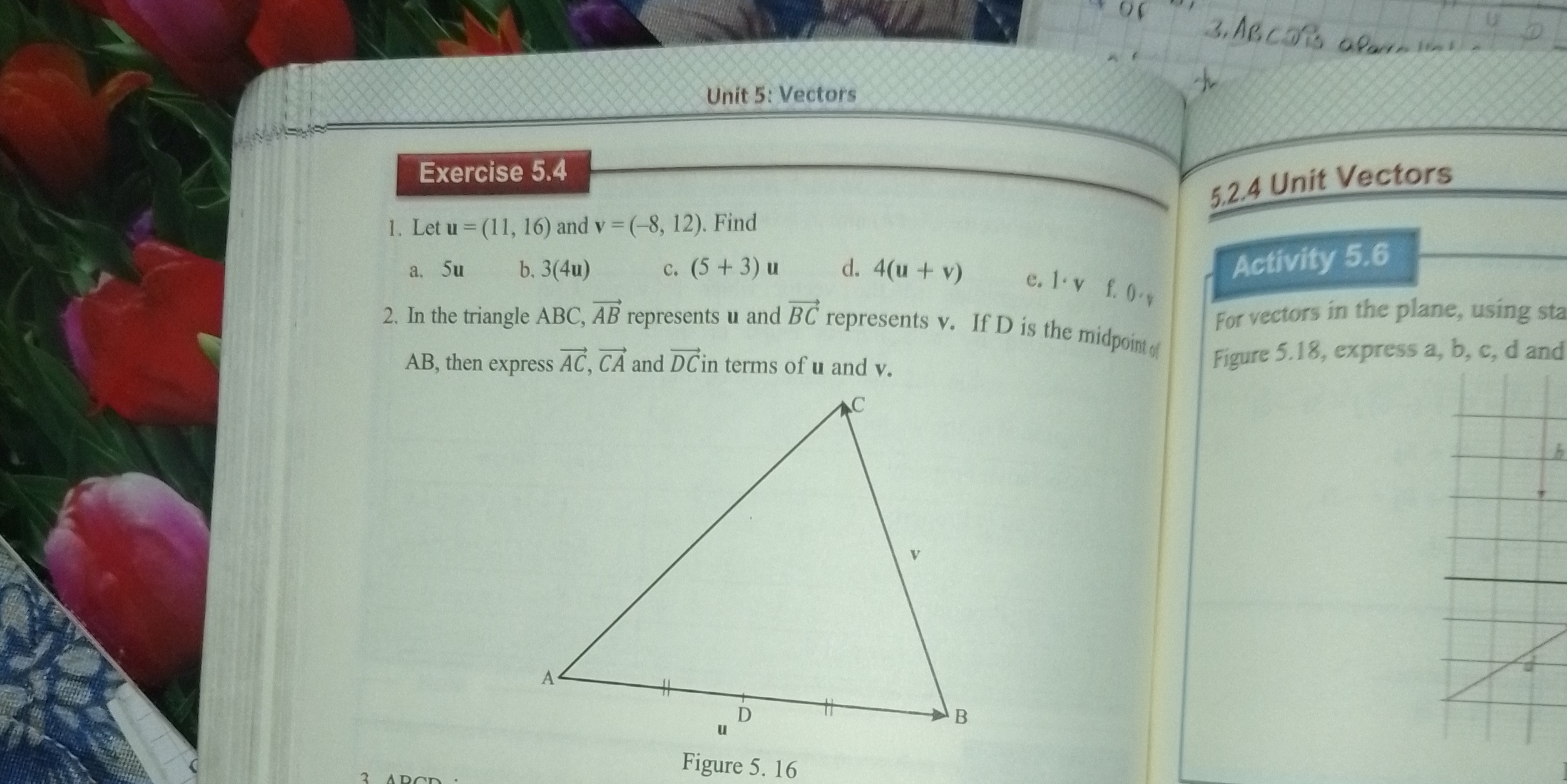In the triangle ABC, $\vec{AB}$ represents u and $\vec{BC}$ represents v. If D is the midpoint of AB, then express $\vec{AC}$, $\vec{CA}$ and $\vec{DC}$ in terms of u and v.

Understand the Problem
The question asks to express vectors $\vec{AC}$, $\vec{CA}$, and $\vec{DC}$ in terms of vectors $\vec{u}$ and $\vec{v}$, given that $\vec{AB} = \vec{u}$, $\vec{BC} = \vec{v}$, and D is the midpoint of AB. We need to use vector addition and the midpoint property to find the required expressions.
Answer
$\vec{AC} = \vec{u} + \vec{v}$ $\vec{CA} = -\vec{u} - \vec{v}$ $\vec{DC} = \frac{1}{2}\vec{u} + \vec{v}$
Answer for screen readers
$\vec{AC} = \vec{u} + \vec{v}$
$\vec{CA} = -\vec{u} - \vec{v}$
$\vec{DC} = \frac{1}{2}\vec{u} + \vec{v}$
Steps to Solve
- Express $\vec{AC}$ in terms of $\vec{u}$ and $\vec{v}$
Using vector addition, $\vec{AC} = \vec{AB} + \vec{BC}$. Since $\vec{AB} = \vec{u}$ and $\vec{BC} = \vec{v}$, then
$\vec{AC} = \vec{u} + \vec{v}$
- Express $\vec{CA}$ in terms of $\vec{u}$ and $\vec{v}$
The vector $\vec{CA}$ is the negative of the vector $\vec{AC}$. Therefore,
$\vec{CA} = -\vec{AC} = -(\vec{u} + \vec{v}) = -\vec{u} - \vec{v}$
- Express $\vec{DC}$ in terms of $\vec{u}$ and $\vec{v}$
Since D is the midpoint of AB, $\vec{AD} = \frac{1}{2}\vec{AB} = \frac{1}{2}\vec{u}$. Now, $\vec{DC} = \vec{DA} + \vec{AC}$. We know $\vec{AC} = \vec{u} + \vec{v}$, and $\vec{DA} = -\vec{AD} = -\frac{1}{2}\vec{u}$. Therefore,
$\vec{DC} = -\frac{1}{2}\vec{u} + (\vec{u} + \vec{v}) = \frac{1}{2}\vec{u} + \vec{v}$
$\vec{AC} = \vec{u} + \vec{v}$
$\vec{CA} = -\vec{u} - \vec{v}$
$\vec{DC} = \frac{1}{2}\vec{u} + \vec{v}$
More Information
These expressions represent the vectors $\vec{AC}$, $\vec{CA}$, and $\vec{DC}$ as linear combinations of the vectors $\vec{u}$ and $\vec{v}$. This allows us to describe these vectors using the given vectors $\vec{u}$ and $\vec{v}$ as a basis.
Tips
A common mistake is to not recognize that $\vec{CA}$ is the negative of $\vec{AC}$. Another common mistake is incorrectly calculating $\vec{AD}$ as $\vec{u}$ instead of $\frac{1}{2}\vec{u}$ because D is the midpoint of $\vec{AB}$. A final common mistake is to make a sign error when calculating $\vec{DC}$, especially with $\vec{DA}$.
AI-generated content may contain errors. Please verify critical information